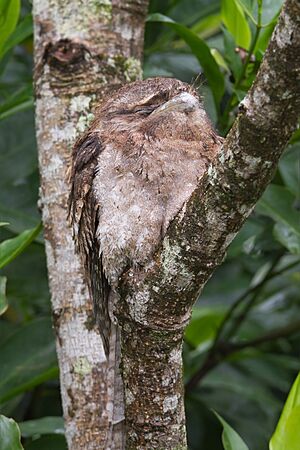Papuan frogmouth facts for kids
Quick facts for kids Papuan frogmouth |
|
|---|---|
 |
|
| Conservation status | |
| Scientific classification | |
| Genus: |
Podargus
|
| Species: |
papuensis
|
The Papuan frogmouth (Podargus papuensis) is a special type of bird. It belongs to the Podargidae family. You can find this bird in places like the Aru Islands, New Guinea, and the Cape York Peninsula in Queensland, Australia.
Contents
About the Papuan Frogmouth
This bird was first described by two scientists, Jean René Constant Quoy and Joseph Paul Gaimard, way back in 1830.
There are three slightly different kinds, or subspecies, of the Papuan frogmouth:
- P. p. papuensis
- P. p. baileyi
- P. p. rogersi
What Does It Look Like?
The Papuan frogmouth is the biggest of all the frogmouth birds when you measure its length. It's one of the largest birds in its group, the Caprimulgiformes order.
These birds are usually about 53 centimeters (21 inches) long. They can range from 50 to 60 centimeters (20 to 24 inches). Males often weigh around 414 grams (14.6 ounces), while females are a bit lighter at 314 grams (11.1 ounces). Their weight can be anywhere from 290 to 570 grams (10 to 20 ounces).
The Papuan frogmouth has a round bill, bright red eyes, and a creamy white stripe above its eye. It also has a long tail and dark wings. Male Papuan frogmouths are usually a bit bigger and darker. They have a marbled pattern on their feathers. Females tend to have more reddish-brown feathers.
The P. p. baileyi subspecies is smaller and darker than the others. The P. p. rogersi subspecies is larger and has paler feathers.
This bird looks a bit like the tawny frogmouth. However, the Papuan frogmouth is larger. It also has red eyes, a longer tail, and darker wings, which helps you tell them apart.
Where Do They Live?
You can find the Papuan frogmouth in the Aru Islands, New Guinea, and the Cape York Peninsula in Australia.
These birds love to live in warm, wet lowland forests. These are called subtropical or tropical forests.
How Do They Behave?
Their Call
The Papuan frogmouth makes a deep, echoing sound. It sounds like a resonant 'ooom' or a laughing hoot. You'll usually hear them calling after the sun sets and before it rises.
Reproduction and Life Cycle
Papuan frogmouths usually lay eggs between August and January. They typically lay one or two white eggs. Their nest is quite simple, made from a few sticks. They place this nest in the fork of a tree branch.
What Do They Eat?
The Papuan frogmouth is a strictly nocturnal bird. This means it is only active at night. It hunts for large insects on the ground after dark. Sometimes, it also catches small reptiles, amphibians, or even other small birds for food.
Some people have observed that the Papuan frogmouth might have a special trick. It may produce a substance in its mouth that attracts flies. It can wait with its mouth open, and flies might fly right in to investigate the smell!
Images for kids
-
A Papuan frogmouth near Cooktown, Queensland.




